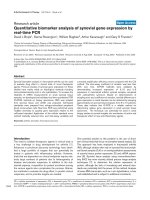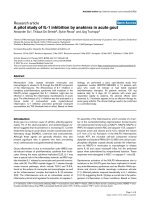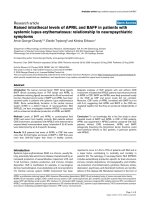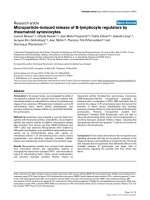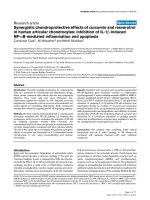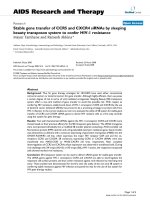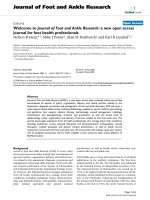Báo cáo y học: "The terrestrial evolution of metabolism and life – by the numbers" doc
Bạn đang xem bản rút gọn của tài liệu. Xem và tải ngay bản đầy đủ của tài liệu tại đây (310.19 KB, 8 trang )
BioMed Central
Page 1 of 8
(page number not for citation purposes)
Theoretical Biology and Medical
Modelling
Open Access
Review
The terrestrial evolution of metabolism and life – by the numbers
Gregory C O'Kelly
Address: 392 Pismo St., San Luis Obispo, CA 93401, USA
Email: Gregory C O'Kelly -
Abstract
Background: Allometric scaling relating body mass to metabolic rate by an exponent of the
former (Kleiber's Law), commonly known as quarter-power scaling (QPS), is controversial for claims
made on its behalf, especially that of its universality for all life. As originally formulated, Kleiber was
based upon the study of heat; metabolic rate is quantified in watts (or calories per unit time).
Techniques and technology for metabolic energy measurement have been refined but the math has
not. QPS is susceptible to increasing deviations from theoretical predictions to data, suggesting that
there is no single, universal exponent relevant to all of life. QPS's major proponents continue to
fail to make good on hints of the power of the equation for understanding aging.
Essentialist-deductivist view: If the equation includes a term for efficiency in the exponent,
thereby ruling out thermogenesis as part of metabolism, its heuristic power is greatly amplified, and
testable deductive inferences are generated. If metabolic rate is measured in watts and metabolic
efficiency is a redox-coupling ratio, then the equation is essentially about the energy storage
capacity of organic molecules. The equation is entirely about the essentials of all life: water, salt,
organic molecules, and energy. The water and salt provide an electrochemical salt bridge for the
transmission of energy into and through the organic components. The equation, when graphed,
treats the organic structure as battery-like, and relates its recharge rate and electrical properties
to its longevity.
Conclusion: The equation models the longevity-extending effects of caloric restriction, and shows
where those effects wane. It models the immortality of some types of cells, and supports the
argument for the origin of life being at submarine volcanic vents and black smokers. It clarifies how
early life had to change to survive drifting to the surface, and what drove mutations in its ascent. It
does not deal with cause and effect; it deals with variables in the essentials of all life, and treats life
as an epiphenomenon of those variables. The equation describes how battery discharge into the
body can increase muscle mass, promote fitness, and extend life span, among other issues.
Background
This paper is a prelude to a rigorous mathematical explo-
ration of the physics of organic batteries and their signifi-
cance for understanding many phenomena of life, which
will be presented in another article.
The second law of thermodynamics states that in a closed
system, one to which additional energy is not available,
the tendency over time will be for that energy to be
equally distributed throughout the system such that net
energy transmission between elements of that system
Published: 27 August 2009
Theoretical Biology and Medical Modelling 2009, 6:17 doi:10.1186/1742-4682-6-17
Received: 24 June 2009
Accepted: 27 August 2009
This article is available from: />© 2009 O'Kelly; licensee BioMed Central Ltd.
This is an Open Access article distributed under the terms of the Creative Commons Attribution License ( />),
which permits unrestricted use, distribution, and reproduction in any medium, provided the original work is properly cited.
Theoretical Biology and Medical Modelling 2009, 6:17 />Page 2 of 8
(page number not for citation purposes)
ceases. This is called heat death. Open systems, in con-
trast, are replenished with energy that allows them to
avoid heat death, at the cost of increased entropy around
them. The difference between closed and open systems is
apparent when the battery is considered. A battery that is
not rechargeable, called a primary cell, is a closed system.
Its power output is dependent upon non-reversible chem-
ical reactions that may be exhausted. In contrast, a battery
that is rechargeable, called a secondary cell, is an open sys-
tem. Its chemical processes are reversible with the capture
of energy from outside it. Both types of systems can occur
as chemical-energy-storage devices, in the form of struc-
tures of organic molecules with covalent bonds. To the
extent that the bio-cell is like a battery, it is a secondary
cell, an open system, some of whose covalent bonds are
reversible. When energy is introduced to or expended by
the cell, how the perturbation in energy storage is equili-
brated throughout the system depends upon the electrical
properties and histology of the biomass.
Thermodynamics has little relevance for open systems,
aside from the equilibration of captured energy through
those systems, especially if they function near equilibrium
already. The capture and expenditure of chemical energy
in the covalent bonds of biomass is the phenomenon of
metabolism. The expenditure of that energy powers
changes in the size, organization, and activity of the bio-
mass. Metabolic rate becomes the recharge rate of that
biomass, expressed in watts, a unit of power.
Kleiber's Law is a power law formulated by Max Kleiber in
the 1930s to fit the data from his metabolic studies of ani-
mals [1]. Kleiber's Law, MR = αW
3/4
, describes the rela-
tionship of metabolic rate (MR) to the biomass W, raised
to an exponent, and multiplied by a correctional constant,
α. Max Kleiber analyzed bio-energy as heat energy, not
chemical energy, for this is all that his instruments
allowed. Originally the exponent of W was taken to be 2/
3, according to the 1883 surface hypothesis of Max Rubner.
This hypothesis related biomass surface area to its volume
in a Euclidean approach to the estimation of heat reten-
tion and loss by the biomass, per unit of surface area.
Kleiber later took the exponent to be 3/4, since his study
of small mammals seemed to support this, though he
could not say why. West, Brown, and Enquist (WBE) alleg-
edly justified the larger exponent, theoretically, in the
journal Science, arguing that the fineness of capillary
branching allowed for greater efficiency of nutrient deliv-
ery to the cells of creatures large enough to have hearts [2].
However, they also claimed the equation applied to bac-
teria and to ecosystems.
The same study that found metabolic-rate-scaling for
endotherms is far closer to the value predicted by Kleiber
than that of ectotherms, on the basis of the study of oxy-
gen and sugar consumption in 229 species [3], reported
numerous deviations from Kleiberian predictions. The
inclusion of thermogenesis in metabolism has clouded
the relevance of the equation. White et al. note, after stud-
ying metabolic rates in 938 species: "there is no universal
metabolic allometry and models that attempt to explain
only quarter-power scaling of metabolic rate are unlikely
to succeed" [4]. Da Silva et al. arrive at a similar conclu-
sion about the lack of a universal exponent, though they
claim it should still be possible to develop a unified the-
ory for the allometric scaling of metabolism if its essen-
tials are known [5].
As handled, Kleiber's Law also has no variable for the
availability of energy, or for the efficiency of its capture
and expenditure, both relevant to the metabolic recharge
rate of all biomass. To amend this, the equation is altered
to include a term, in the exponent, for metabolic effi-
ciency (ME) of the biomass W. This term is a ratio of the
efficiency of redox coupling between the biomass battery
W, and the sources of chemical energy available to it,
measured against loss to heat. ME is therefore a ratio of
amperes of anabolism to amperes of catabolism. The
recharge rate of the organic battery is influenced not just
by the size of the mass, as Kleiber would have it, but also
by the availability of energy to it, and by the ability of the
organic battery to capture and expend this energy. These
two are expressed as the denominator and numerator of
ME. Biological organization is based upon and con-
strained by energetics.
The sophisticated version of Kleiber's Law becomes MR =
αW
(4ME-1)/4ME
. The ratio ME includes the effects of temper-
ature on the electrochemical processes underlying redox
coupling, but does not include the energy used to generate
that temperature. When graphed with a different curve for
each W (Fig. 1), values like those that appear in standard
log-log graphs of mass vs MR occur when ME is between
100% (3/4) and 89% (2/3) (Fig. 2), something that never
happens in biological or chemo-mechanical systems. The
sophisticated version of Kleiber seems to remove the
equation, as widely handled, from having any biological
relevance whatsoever. This lack of relevance follows from
misinterpretation of the role of thermogenesis in metabo-
lism, which would account for the preposterously high
exponents. Values for ME, realistically, are going to be
much lower than 100%. At an ME of 20%, the exponent
is -1/4. At around 33% the exponent is +1/4. At 25% ME,
the exponent is 0. Fig. 1 reveals attractors at 25% ME and
one gram mass. An interpretation of its curves follows.
The highlighted numbers in Additional file 1 are those
appearing as curves on Fig. 1, with a different curve for
each value of W.
An examination of graphs and table
Decrease in ME from increased energy availability (the
denominator of the ratio) is the inefficiency of abundance
Theoretical Biology and Medical Modelling 2009, 6:17 />Page 3 of 8
(page number not for citation purposes)
Metabolic efficiency vs. metabolic recharge rate, with a different curve for each massFigure 1
Metabolic efficiency vs. metabolic recharge rate, with a different curve for each mass. The curves shown are for
the numbers highlighted in Additional file 1, and indicate how recharge rate changes for each mass as energy availability fluctu-
ates, or as the ability of that mass to absorb energy changes. Both are expressed as values for metabolic efficiency, the X axis.
Theoretical Biology and Medical Modelling 2009, 6:17 />Page 4 of 8
(page number not for citation purposes)
(Ia). Increase in ME from decrease in energy availability is
the efficiency of scarcity (Es). Ia and Es are passive changes
due to circumstance. ΔME from Ia or Es results in changes
in MR that are non-equilibrium deviations from an aver-
age MR. The immediacy and endurance of these perturba-
tions pressures lagging, compensatory changes in the
numerator of ME so that equilibrium is re-established.
ΔME-driven fluctuations in MR are equilibrated by Ep (the
efficiency of production), or by Id (the inefficiency of deg-
radation). Both Ep and Id are due to changes in the
numerator of ME. In the case of Ep, the organic battery
functions as a secondary cell, where energy is captured as
mass in reversible chemical reactions, e.g., as phosphor-
ylation, glycogenesis, or the synthesis of NADH. In the
case of Id the organic battery functions as a primary cell,
where power is either expended or lost from catabolic
reversal of anabolic chemical reactions, or its rate of cap-
ture is reduced. Equilibration pressure acts to change size,
organization, and activity of W. For W less than one gram,
increased Ia at less than 25% ME causes the MR of W to
increase drastically, enchaining thermodynamic, equili-
brating pressures to increase W through Ep, to lower MR.
Absorption of energy as mass is met by MR drop. W,
responsive to fluctuations in ME from Ia, is shaped by per-
turbations of MR that pressure for reversibility in W's
structure. All Ws not able to absorb energy from Ia, as
increased mass in the anabolic process of Ep, are
destroyed by that energy, as Ia becomes Id.
At less than one gram, should increasing W from Ia reduce
MR below average (given prevailing ME < 25%), equili-
bration pressure acting through Id reduces W and restores
MR. Over time this reduction and its reverse will be
selected for its reversibility, and will occur as division and
growth. Sophisticated Kleiber represents replication/divi-
sion and metabolism as inseparable, where replication is
seen as reductions in biomass W due to the electrical
properties of organic molecules, given ΔME and thermo-
dynamic pressure for equilibrium.
The graph and table reveal key seams or attractors along
the values one gram for W, and 25% for ME. These seams
The standard log-log graph of mass vs. metabolic rate, where each mass is a point on a line rather than a separate curveFigure 2
The standard log-log graph of mass vs. metabolic rate, where each mass is a point on a line rather than a sepa-
rate curve. This graph is concordant with the archaic practice of including thermogenesis as part of metabolism, and the
measuring of metabolism with the creature as close to equilibrium as possible, i.e., no food, no activity.
Theoretical Biology and Medical Modelling 2009, 6:17 />Page 5 of 8
(page number not for citation purposes)
are not discontinuities. The lack of discontinuities from
things as small as individual molecules, synthesized by a
Miller/Urey lightning bolt for example, to large, single-
celled organisms, further suggests that the growth of bio-
mass to micelle and then to cell was continuous, and did
not await a proto-cell wall of iron sulfide, or any other
bioenergetic, structural arrangement with which some dis-
continuity that would mark the difference between life
and non-life might occur. Instead, the origins of life
appear as the result of aggregation of organic molecules.
The boundary between life and non-life, it appears, is a
matter of W's scale, where iteration of the redox dynamic
is repeated at all scales.
This is seen in the life-like activity of calcium phosphate
and carbonate particles once associated with what were
called nano-bacteria [6]. Recent research has found a mul-
titude of voltage differences within the cell that drive
intracellular activity that can in no way be accounted for
simply in terms of cell membrane voltages [7]. Sophisti-
cated Kleiber models the evolution of form as not sudden
or abrupt, but extremely gradual. Along these seams the
equilibration of MR requires the least drastic changes in W
for minor perturbations in MR.
Note that, at one gram, W's MR is the same for all MEs.
Note also that at 25% ME the MRs for all Ws intersect.
With ΔME occurring as passive changes in energy availa-
bility (Ia and Es), all Ws are met with changes in MR,
except at one gram. The largest single-celled organisms,
and the smallest mammal, are about one gram mass. It is
no surprise that all life operates close to 25% ME, and that
life's phases are frequently dictated by fluctuations to
either side of 25% ME. Thermodynamics and unending
fluctuations in ME drove evolution, from its beginning at
submarine volcanic vents, where the secondary cell
aspects of the bio-battery reigned in an energy-rich envi-
ronment characterized both by ultraviolet radiation given
off by a high-temperature mass in decompression cooling
and magma formation, and by the richness of coulombs
given off by the oxidation of hydrogen sulfide spewed into
water to become sulfurous acid. This energy was absorbed
as increased biomass, where the primary-cell aspects of
the organic battery permitted the biomass to survive
increased energy scarcity away from volcanic vents by
allowing for reversible Id to counter Es.
The escape of W from high-energy environments awaited
Ep's development then, facilitating not only mass
increase, but also the organization of early W's constitu-
ents or organelles, so that Es from energy scarcity could be
absorbed by Id. Mass increase, occurring as the formation
of shells, the inclusion of iron in the structure (phyto-
plankton), or the aggregation of smaller w's into larger Ws
(quorum sensing), at ME's over 25%, according to Fig. 1,
results in increased MR for all Ws. At ME < 25%, however,
increased W results in lower MRs. The rule is: passive ΔME
over time (Ia and Es) triggers changes in the size and
organization of W, by acting upon Id and Ep. These
changes occur as proliferation, growth, and development
of the organic battery, a storage device for coulombs.
More importantly, as W drifted away from hydrothermal
vents, changes in its structure allowed it to engulf particles
upon which it could act catabolically, in the form of Id –
acids acting upon covalent bonds, such that Id could be
converted to Ia. This capacity supplemented the second-
ary/rechargeable cell aspects of early biomass with a pri-
mary battery aspect, at smaller scales, and ultimately
became the activity of lysosomes and other aggregated,
cellular organelles; and, at larger scales, became gastrula-
tion. The delivery of these particles to the cells of sponges,
corals, and tubeworms, at first dependent upon tides and
currents, was later replaced by vascular systems in organic
batteries with hearts.
Changing scales
One cogent criticism leveled against WBE's handling of
Kleiber, which claims to relate BMR to the W of the multi-
cellular organism, is that BMR cannot possibly account for
motor activity of W. Blood flow and primary cell-battery
activity alone is not sufficient to power the great spikes in
MR necessary for the sustained activity of large creatures.
This is where FMR, the field MR of W that includes its
activity, exceeds the BMR of its constituent parts (only at
over 25% ME). WBE proposes FMR of the organism is the
product of average BMR and number of cells [8]. This ver-
sion not only attributes no role to the efficiency of the
organization of the cells of W, but also clashes with the
fact that, at under 25% ME, BMR exceeds FMR for all W.
Ws of this sort are seen in such creatures as parasitic
worms and fungi embedded in a food source, or small
mammals that routinely function at an average ME less
than 25%. In fact the appearance of large mammals
awaited the development of nervous systems that allowed
for greater Ep, the rate at which coulombs are captured as
neuronal ATP, for example, in the redox coupling that is
neurogastric. This allowed average ME to exceed 25%.
Otherwise more massive mammals at less than 25% ME
would have lower FMRs and shorter lives. This phenome-
non can be seen in dogs and cats. Larger dogs live shorter
lives, with an average ME just below 25%, while larger
cats, including tigers and mountain lions, live longer than
dogs, and have an average ME just over 25%.
Ws that function at an ME less than 25% are generally able
to benefit from the effects of caloric restriction (Es) on
longevity. There is a slight cushion before FMR exceeds
BMR, when ME goes over 25%. This cushion is missing for
all organisms that function at or over 25% average ME.
For all these latter organisms FMR exceeds BMR, and so
Theoretical Biology and Medical Modelling 2009, 6:17 />Page 6 of 8
(page number not for citation purposes)
the maximum potential life span of the creature is greater
than that of its cells. It is important to note that average
ME for the organism is the same for all its constituent
parts. The organism determines ME by the success of its
ability to capture energy from food or photosynthesis. It is
shared ME that defines organism wholeness, and is the
basis of biological organization. That is why there are
stem cells for all somatic structures, including nervous tis-
sue, for Ws whose average ME is greater than 25%; and
why the effects of caloric restriction on longevity for these
creatures is threatening to BMR, which drops dramatically
as ME increases over 25%. Herein lies the secret to aging
and its associated decrepitude. It is a matter of the antag-
onism between FMR and BMR. The same dynamic is char-
acteristic of flora, where BMR for the cells, renewed with
the seasons, allows the organism comprised of those cells
to live longer than any of them.
The phenomenon known as quorum sensing, when bacte-
rial cells start doing things as a colony that no bacterium
has the energy to do on its own, is something that occurs
when Es drives ME over 25%. At this time the FMRs for W
exceed the BMRs of W's constituents, and further increases
in mass of W increase its FMR. The bacterial colony is W.
An example of quorum sensing is the creation of biofilms,
whether in the gut or on coral, where bacterial films act as
a net to ensnare tide-borne particles that may be subjected
to Id/catabolic breakdown. No individual bacterium has
the MR to create these films, or to synthesize the pili that
are associated with energy equilibration throughout the
bacterial colony responsible for the film [9]. Quorum
sensing is what was behind the oldest fossils of bacterial
colonies on earth, the stromatolites found in the shallows
off the coast of Australia. Stromatolites are the structures
left after bacterial colonies have been encased in and
inundated by water-borne sediments.
What separates flora from fauna and bacteria is the electri-
cal properties of the relevant biomass. An ohmmeter will
read a resistance from one point to another on any fauna,
or in a bacterial colony; but not so with flora. Flora are not
dielectric; their extracellular structures act as an insulator,
except at exceedingly high voltages. Flora do not then
equilibrate chemical energy extracellularly, and are not
capable of motor behavior, which must be distinguished
from phototropism. Motor behavior involves the equili-
bration of energy captured by biomass in the catabolic
breakdown of a food/energy source, and should be distin-
guished from seemingly-directed, intracellular traffic of
molecules driven by electrical fields. Motor behavior
extends from a bacterial flagellum or the rotary-mecha-
nism of the ATP-synthase complex, to the peristalsis of
smooth muscle responding to local conditions, or to the
skeletal articulation of striated muscle driven by nervous
system discharge of neuronal ATP hydrolysis (Id).
Because the sophisticated version of Kleiber's Law is math-
ematical, deductive inferences can be made from it that
can be tested. The forces and pressures it purports to
model, said to be responsible for the origins, evolution,
development and replication of all life, and claimed to
define the parameters within which all genetic variation
must be limited, are still at work. The equation models
how Ia at the basal level, appearing as the digestion of
food, causes perturbations in BMR of key structures of the
gut. These perturbations are in turn equilibrated by Ep at
the field level, appearing as phosphorylation in the neu-
ron. Equilibration of MR perturbation from the introduc-
tion of this energy is not yet complete, and involves
further Id at the field level, where Ep is replaced by Id,
associated with nervous system trophism. Extrapolation
from additional file 1 suggest that, if life span is directly
related to MR or recharge rate, and if the ME of the organ-
ism applies to its cells, then the life span of an ATP mole-
cule is very brief before its energy is lost as heat (if it is not
used for something else), in organisms with a high aver-
age ME (over 25%). In organisms of increased encephali-
zation, where average ME exceeds 25% because of Ep
rather than Es, this Id breakdown of ATP acts as a sort of
trickle-charger, providing Ia to all post-synaptic structures.
This effect accounts for the warm-bloodedness of mam-
mals, especially large mammals, with the heat as lost
power in transmission, and higher ATP turnover rates due
to lower MRs for ATP-organic molecules consonant with
higher organismic MEs.
This sort of trickle-charger transmission drives the motor
activity necessary to acquire more food, and also occurs as
nervous system trophism. The redox dynamic is Ia from
food » Ep (field level neurogastric/redox coupling result-
ing in ATP synthesis) » Id (neuronal dephosphorylation)
» Ia (basal level nervous system trophism). Ep from food
sources occurring as mass not readily reversible through
Id (e.g., fat instead of ATP, where Ia from food is con-
verted to Ep at the basal level without neurogastric cou-
pling at the field level), if pronounced, can result in mass
increase interfering in the transmission necessary for
motor activity and trophism. This is the point of empirical
entry into testing a hypothetical inference from the math
on a human W in a clinical setting. A battery discharging
into the body at the electrochemical, peripheral nerve
endings, the hypothesis suggests, will cause BMR for the
cells of the post-synaptic structure to fluctuate in what is a
simulation of the conversion of neuronal Id into somatic
Ia (nervous system trophism). This simulated trophism
acts on the secondary bio-battery aspect to induce anabo-
lism there, by reversing key chemical reactions associated
with metabolic functioning, like the hydrolysis of ATP or
the catabolic breakdown of NADH to NAD
+
. The reversi-
bility process has roots in the secondary-cell aspects of
biomass, but without diminution of FMR from neuronal
Theoretical Biology and Medical Modelling 2009, 6:17 />Page 7 of 8
(page number not for citation purposes)
Id to power the reversibility. Effectively, BMR and FMR are
increased simultaneously, without the need for neuronal
Id to complete energy distribution from gastric to somatic
cells and structures. If effective ME at the basal level is
reduced to less than 25%, energy will be absorbed as
increased mass, occurring as increased protein density.
When the somatic structure is muscle, muscle cell mass
will be seen to increase. Ep and Ia will be triggered simul-
taneously, without antagonism between the two, without
increased consumption of food, and without antagonism
between BMR and FMR. The discharging battery acts as a
second stomach, with its anode acting as nervous system
neuronal Id. Over time mass increase will enhance sys-
temic efficiency by acting upon the density of the protein
structure of the organism's cells, such that average ME and
FMR increase, extending life span of Ws over one gram in
size, without the normal drops in BMR associated with
increased ME in organisms of that size.
There are 0.86 nutritional calories in 1 watt-hour. If an
open circuit voltage of 100 volts DC pulse-delivers an
average of 30 milliamperes at a frequency of 900 Hz. for
one hour, the watt-sec rating is 0.168, and that translates
to 604 watt-hours. Delivered transcutaneously to the
body's 1,152 motor endplate region/neuromuscular junc-
tions for 1 second each, the result is 0.32 hours of stimu-
lation, for 193.3 watt-hours. This means 166.2 calories
were introduced to biomass W from the battery. The ques-
tion then becomes, how well were the watts absorbed so
that organism Ep and basal Ia are affected, and FMR and
BMR are increased with this momentary change in ME?
A 75 kg human with an ME of 31% will have a maximum-
potential-life-span (MPLS)/FMR of 8.8. A caloric intake of
2000 calories/day translates to 620 calories converted to
ATP, motor behavior and protein mass, while the rest is
lost as heat, or passed as undigested matter. If electro-
chemical stimulation increases ATP and protein synthesis
at 100% efficiency, effective calories from food increases
from 620 to 786. This puts ME at 39% momentarily, and
raises MPLS to well over 200 years (if an MPLS of 8.8 is
taken to be roughly equivalent to 88 years) – if that ME is
sustained as an average. But it is not. It is momentary,
though it does have an effect on average ME.
Capture of energy, as ATP/protein synthesis from electro-
chemical stimulation, is limited to the same restrictions
that govern the turning of Id to Ia through exercise. The
effective conversion of energy from Id to Ia is limited by
the resistance to transmission of energy from the chemical
synapse at the nerve ending to the electrical synapses at
the gap junctions of the cells of somatic structures where
ion channels form electrochemical salt bridges to the
intracellular space. Transmission on smooth and striated
muscle is dependent upon the cross-sectional area of the
Type II muscle fiber. Muscle mass is determined by this
cross-sectional area. Weak muscles have diminished cross-
sectional area, and are hard to build and restore, regard-
less of how much activity or exercise is involved, because
the power delivered to them is dependent upon their abil-
ity to absorb it, and this ability is dependent upon their
fitness. The less the cross-sectional area, the less likely it is
that Id can drive down Ia to less than 25%, a requirement
for the absorption of energy as muscle mass. Prolonged
cutaneous exposure to the anode can overwhelm the skin
cells with an Ia they can't absorb, causing them to blister
and burst as Ia is converted to Id for these cells. Skin irri-
tation from electrical stimulation of muscle traditionally
has been avoided through the use of a biphasic voltage
waveform. This type of waveform prevents the use of elec-
trochemistry, only possible with a monophasic waveform.
This is why electrical muscle stimulators have not been
able traditionally to build muscle. Biphasic waveforms
cannot increase Type II fiber cross-sectional area necessary
for muscle-mass building because they do not pass amper-
age.
Conclusions: testing the equation
If, over time, average ME of the 75 kg human biomass is
increased by 8%, going from 31% ME to 33.5%, from
changes in the histology of the biomass, MPLS increases
from 8.8 to 17.3, more than doubling possible life span.
If average ME is increased only to 31.5%, MPLS/FMR
increases to only 10.0. These are deductions from the
equation. If the inferred predictions are found, upon test-
ing, to increase human life span, and to build muscle
mass, this will offer support to the idea that sophisticated
Kleiber does indeed truly model the forces and pressures
that are behind the appearance of life from chemistry,
without resort to the particularities of cause and effect.
Other testable predictions present themselves. The equa-
tion suggests that, given the wide range of flatworm
genome mass, average genome mass for parasitic flukes
will be far less than that for planarians, on the basis of an
ME reflecting the eating habits and lifestyle of the two
types of flatworm. The equation suggests that birds live
longer than rats of equal mass because the birds, eating
less, operate at a higher ME than rats – with rats at or
around 20%, and birds at or around 30%. This is also why
bigger birds live longer lives, while bigger rats live shorter
lives. The equation implies that the Id that leads to genetic
mutation is more likely to occur in creatures that operate
at higher ME, where either food supply is barely adequate,
or where neurogastric energy distribution, from Id to Ia at
the basal level, is impeded by histological deterioration,
as in the aged and infirm. In the former case what is seen
is species diversification, while in the latter what is seen is
cancer and degeneration. Inferences from the math,
including the application of electrochemistry to amelio-
Publish with BioMed Central and every
scientist can read your work free of charge
"BioMed Central will be the most significant development for
disseminating the results of biomedical research in our lifetime."
Sir Paul Nurse, Cancer Research UK
Your research papers will be:
available free of charge to the entire biomedical community
peer reviewed and published immediately upon acceptance
cited in PubMed and archived on PubMed Central
yours — you keep the copyright
Submit your manuscript here:
/>BioMedcentral
Theoretical Biology and Medical Modelling 2009, 6:17 />Page 8 of 8
(page number not for citation purposes)
rate or mitigate problems of health and fitness, need to be
addressed.
Competing interests
The author declares that he has no competing interests.
Additional material
References
1. Kleiber M: Body size and metabolism. Hilgardia 1932, 6:315-353.
2. West GB, Brown JH, Enquist BJ: A general model for the origins
of allometric scaling laws in biology. Science 1997, 276:122-126.
3. Nagy K: Field metabolic rate and body size. J Exp Biol 2005,
208:1621-1625.
4. White CR, Phillips N, Seymour R: The scaling and temperature
dependence of vertebrate metabolism. Biol Lett 2006,
2(1):125-127.
5. Da Silva JKL, Garcia G, Barbosa LA: Allometric scaling laws of
metabolism. Phys Life Rev 2006, 3(4):339-361.
6. Martel J, Ding E, Young J: Purported nanobacteria in human
blood as calcium carbonate nanoparticles. Proc Natl Acad Sci
USA 2008, 105(14):5549-5554.
7. Lightning Bolts within Cells [ />Biotech/19841/?a=f]
8. Savage VM, Allen AP, Brown JH, Gillooly JF, Herman AB, Woodruff
WH, West GB: Scaling of number, size, and metabolic rate of
cells with body size in mammals. Proc Natl Acad Sci USA 2007,
104(11):4718-4723.
9. Reguera G, Pollina R, Nicoll J, Lovley D: Possible nonconductive
role of Geobacter sulfurreducens pilus nanowires in biofilm
formation. J Bacteriol 2007, 189(5):2125-2127.
Additional file 1
Metabolic rates for a range of biomass vs. metabolic efficiency. the
data provided present metabolic rate/lifespan in numbers, with metabolic
efficiency increasing from top to bottom, and biomass in grams from left
to right. Highlighted values are those that appear on the graph in Figure
1. Notice the seams at which the value for metabolic rate remains con-
stant. They occur at one gram and 25% efficiency, at which the value for
metabolic rate is 1.0. In terms of lifespan, when compared to observed-life-
spans of organisms big and small, the value of 1.0 approximates around
ten years.
Click here for file
[ />4682-6-17-S1.pdf]


